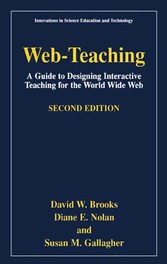Web-Teaching - A Guide for Designing Interactive Teaching for the World Wide Web
von: David W. Brooks, Diane E. Nolan, Susan M. Gallagher
Kluwer Academic Publishers, 2002
ISBN: 9780306476822
Sprache: Englisch
342 Seiten,
Download: 19232 KB
Format: PDF, auch als Online-Lesen
eBook anfordern
▸
Mehr zum Inhalt

Web-Teaching - A Guide for Designing Interactive Teaching for the World Wide Web
When the first edition of Web-Teaching was written, in late 1996, the Web seemed to be emerging as a powerful force in education. The half-decade since has seen remarkable instructional innovation based upon the Web. At the same time, seeking the goose that lays the golden egg, college administrators with little or no technical expertise have driven faculty to create Web courses. Distance education went out; extended education came in. Politicians began to anticipate substantial instructional savings. Thus far, any profits have been minimal and any savings experienced have been small ones.
Web courses and Web-based course supplements have popped up all over all over the world. No central force has yet emerged which dominates the field. Indeed, nearly every college, from the large to the small, has become a player. Tremendous, broad-based Web-delivery activity has characterized the last few years of the 20th century. Elementary students publish Web-sites. Teachers use Web-pages to communicate with parents.
Web-commerce has flourished. The wave of Web-commerce has paled that of Web-teaching. The infrastructure that is emerging to support Web-commerce ultimately will permit piggybacking of Web-teaching. We can expect fast Web access to be available in students' homes.
We see this edition as continuing to offer helpful, research-based suggestions to teachers who would improve their teaching using the Web. The first edition of Web-Teaching was somewhat dated when it came off the press. This edition also shoots at a quickly moving target. Much has happened in four years. Little has happened, however, to modify the principal messages of the first edition. This edition attempts to focus reader attention on research reported from the early days of Web teaching.
There are six things we can say about Web teaching at this time:
1. Course Management Software (WebCT, CourseInfo) has emerged and been embraced strongly by teachers. As a result, the number of teachers whose courses have some Web presence is mushrooming. For our first edition, Web teachers who managed their own servers represented a large fraction of those using the Web. This no longer is so; today few teachers manage their own Web servers.
2. The first edition suggested that Web teaching might not be successful in certain content areas. It turns out that Web teaching can be applied to nearly any non-laboratory course in the curriculum. Even portions of some laboratory and studio courses have been handled well on the Web.
3. While extensive studies are not available, early results suggest that students in Web courses learn about the same amount as do students in traditional courses. Drop out rates in Web-based courses are higher than in traditional courses, but similar to other distance courses.
4. There have been no results that suggest strong learning gains from multimedia approaches to teaching. Thus far, it appears that media have small effects. Active learning approaches have larger positive effects on learning outcomes.
5. Many teachers have developed Web supplements for their courses. There is very strong evidence that the students who use these resources learn better than those who do not.
6. Very few teachers have enjoyed time efficiencies as the result of developing a Web presence. Quite the opposite; teachers find that Web courses take more time. This is especially true of courses involving discussion, where reading Internet-based discussions can become an enormous chore.
A major difference between this edition and the first edition is that this edition was first created on the Web, and then converted to paper. The number of chapters has been increased. Several topics have been included that were missing in the first edition. For example, we devote a chapter to a discussion of Web courseware applications. Courseware helps teachers to organize and deliver courses that are entirely Web-based. We also stress the metacognition of the Web, those core skills that help us know what to do whenever we use the Web as an information gathering or transmitting tool. David Brooks notes, with great personal regret and sense of loss, the passing of his friends and mentors Frank Collea and Alvah Kilgore. They both were prime movers of the first edition.
David W. Brooks
Diane E. Nolan
Susan M. Gallagher
Lincoln, Nebraska
August, 2000









